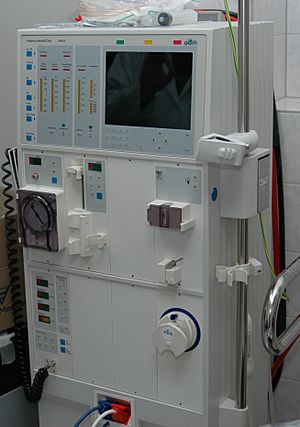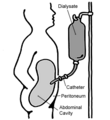Dialysis facts for kids
Dialysis is a special medical treatment. It uses a machine to do the job of your kidneys when they stop working properly. The word dialysis comes from ancient Greek words. Dia means "through," and lusis means "loosening" or "separating." So, it's about separating things from the blood.
Your kidneys are super important organs. They help keep your body healthy by balancing water and minerals. These minerals include things like sodium, potassium, calcium, and magnesium. Kidneys also remove waste products and extra water from your blood. When kidneys fail, these wastes build up, which can make a person very sick.
Dialysis can help people whose kidneys have stopped working for a short time. It also helps people whose kidneys no longer work at all. The machine cleans the blood and helps keep the body's minerals in balance. However, kidneys also make important hormones like erythropoietin. Dialysis machines cannot make these hormones.
How Dialysis Works
Dialysis machines work using two main ideas: diffusion and ultrafiltration. Imagine a very fine filter, like a super thin screen. This filter is called a membrane. Blood flows on one side of this membrane. On the other side, a special liquid called dialysate flows.
The dialysate is a special fluid with different chemicals in it. A doctor decides the exact mix of chemicals needed for each patient. This fluid often has bicarbonate to help balance the acid levels in the patient's blood. As the blood and dialysate flow past each other, waste products from the blood move through the membrane into the dialysate. This process cleans the blood.
The Dialyzer: An Artificial Kidney
A dialyzer is the main part of a dialysis machine. It acts like an artificial kidney. It's usually a clear tube with openings for blood to enter and leave. There are also openings for the dialysate liquid.
Inside the dialyzer are many very thin fibers, like tiny straws. These fibers are made of a material that works as a semi-permeable membrane. This means it lets small things pass through but blocks bigger things. There are about 10,000 of these tiny fibers!
Waste products, like urea, are small enough to pass through these fibers into the dialysate. But important blood cells are too big. They stay in the blood. A pump in the dialysis machine makes sure the clean dialysate flows in and the "dirty" dialysate (with the waste) flows out. This whole process helps clean the blood and keep the body healthy.
Images for kids




